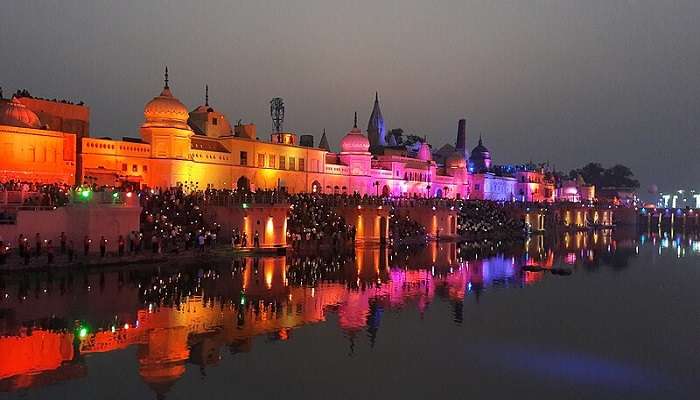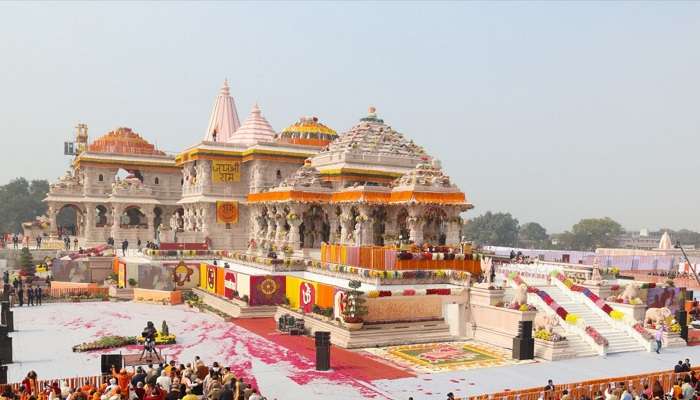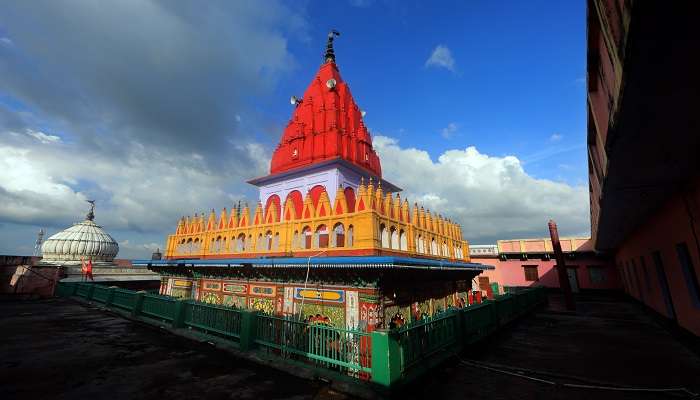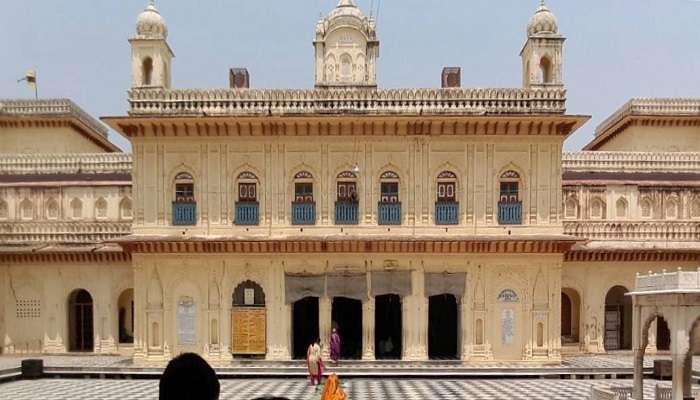Discover The Sacred Calm And Serenity Of Naya Ghat In Ayodhya On Your 2025 Vacay

Naya Ghat, located on the banks of Sarayu River is one of the major tourist spots near Ayodhya. It is a representation of spiritual dedication and ageless historical wealth. This location, which stands by the Sarayu River, is significant in Hindu history and mythology. This tranquil location’s waters draw pilgrims, visitors, and residents. The location exudes a sacred aura that permeates the surrounding area. The rites performed here imbued the pilgrims with a sense of commitment and resolve. Locals living around this place are embodied with a sense of sacredness and purity.
History Of Naya Ghat

The history of this place dates back to several centuries. Ayodhya is the birthplace of one of the greatest deities of Hindu Mythology, Lord Rama. History says that Ayodhya used to be the capital of the ancient Kosala Kingdom and the residence of Lord Rama during the Treta Yug. Naya Ghat is primarily located on the banks of the River Sarayu and has undergone several reconstructions and renovations over time but has managed to keep its cultural identity safe and sound. The place has been influenced by many ruling dynasties who have left their architectural styles, art and culture behind.
Naya Ghat is flooded with pilgrims during the festivals and religious ceremonies dedicated to Lord Rama and other deities. It is believed that taking a bath in the waters of the River Sarayu situated at the Naya Ghat cleanses an individual’s sins and helps him live a healthy life. The ghat is beautifully decorated during the festivals of Diwali, Kartik Purnima, and Ram Navami.
During these occasions, this place completely transforms into a vibrant place where loud changing, devotional music and religious rituals are held.
Must Read: Ayodhya Ram Mandir
Places To Visit Near Naya Ghat In Ayodhya
From the sacred Ram Janmabhoomi Temple to the enchantingly beautiful Kanak Bhawan. Here are some amazing places near Naya Ghat you must visit.
1. Ram Janmabhoomi Temple

This temple is located in the vicinity of Naya Ghat in Ayodhya. Ram Janmabhoomi Temple marks the birth of Lord Rama. This is the exact place where Lord Rama was born. The temple is the most revered pilgrimage site and witnesses devotees in large numbers. The temple was inaugurated on 22nd January 2024 and received almost half a million devotees flocking to the place. The temple was built at the place believed to be Lord Rama’s fortress. The Janmasthan in Ayodhya is of the utmost importance as the temple is exactly located at this place.
2. Hanuman Garhi

Hanuman Garhi is a temple that is solely dedicated to Lord Hanuman. This temple is situated on the top of a hill near Naya Ghat. Because of its high altitude on the hill, this place offers panoramic views of the entire Ayodhya. The temple is a popular spot for both devotees and nature lovers. Locals say that it is a custom to visit the Hanuman Garhi temple before visiting the Ram Janmabhoomi Temple. This temple is controlled by the “Bhairagi Mahants” particularly of the Ramanandi Sect. Hanuman Garhi is believed to be the place where Hanuman Ji started living.
Suggested Read: Hotels In Ayodhya Near Kanak Bhawan
3. Kanak Bhawan

Kanak Bhawan is a beautiful temple dedicated to Lord Ram and his beloved wife, Goddess Sita. It is located in the north-east of Ramkot. This temple is widely appreciated by tourists and devotees for its intricate architecture and vibrant religious ceremonies. Locals believe that this palace was gifted by Kaikeyi to Lord Rama and Goddess Sita immediately after their marriage. It seems that this palace is their personal palace. Mythology says that the original Kanak Bhawan was destroyed but later on was reconstructed by Krishna himself in the Dwapar Yug. There are three pairs of idols here.
Things To Do At Naya Ghat, Ayodhya

Tourists and visitors are recommended to indulge in a variety of activities to make their trip to Naya Ghat a memorable one.
1). Attend Morning Aarti: Witnessing the morning Aarti at Naya Ghat is refreshing. Devotees can see priests worshipping the holy waters of the River Sarayu and offering prayers to the rising sun.
2). Boat Ride: A boat ride on the river gives you broad water vistas around you. Tourists can see temples on the river Sarayu’s banks in the city of Ayodhya.
3). Explore Temple: Ayodhya is one of the holiest cities in India. This city has many historical temples. Visit nearby temples such as Ram Janmabhoomi Temple, Hanuman Garhi, and Kanak Bhawan to pay homage to Lord Ram.
4). Participate in Festivals: Ayodhya has seen many pilgrims visit during occasions and festivals. It is recommended to visit this place on Diwali, Hanuman Jayanti, or Ram Navami.
Suggested Read: Hotels In Ayodhya
Local Cuisine Of Ayodhya

Ayodhya is famous all across India for its varied and simply amazing local cuisines. Here are some local cuisines of Ayodhya you must try.
1). Litti Chokha: This meal is part of the native cuisine in Varanasi, yet it originates in a neighbouring state in Bihar. Made with wheat flour, Litti is filled with a blend of gram flour that has been roasted. Roasted until it reaches a golden brown colour. Chokha, a smokey mixture of brinjal, tomatoes, onions, and garlic, is eaten with Litti and gives your taste buds a savoury kick.
2). Til Laddoo: Til Laddoos are made during the festivals of Makar Sankranti in Ayodhya with sesame seeds and jaggery, sometimes flavoured with cardamom.
3). Malai Ki Gilori: This sweet dish is made from thickened milk solids, stuffed with dry fruits, dipped in sugar syrups, and garnished with Varak.
4). Thandai: Locals here welcome guests with cool Thandai. This traditional drink is prepared with milk, chopped nuts, saffron, almonds, and spices.
5). Puri Sabzi: The sole traditional Indian food offered for breakfast, lunch, and dinner is Puri Sabzi. Puri, a wheat flour-based deep-fried bread, is offered by Puri Sabzi together with a flavorful hot potato curry. You’ll be amazed when you pair this delicious potato curry with the crispy texture of puri.
Further Read: Places To Visit In Varanasi
Naya Ghat embodies the essence of India’s spiritual and cultural heritage. The historic significance of this place is often combined with the supreme festivities celebrated in this place. Serene ambience offers visitors a sense of connection not just with nature but with this holy town too. Tourists’ profound journey and trip to Ayodhya is just going to be worth it while exploring the Naya Ghat and other attractions nearby. Naya Ghat provides peace and a spiritual sanctuary where devotees, locals, and tourists alike can find solace and enlightenment. The backdrop and scenic beauty are a plus one.
For our editorial codes of conduct and copyright disclaimer, please click here.
Cover Image credit : By रूही for Wikimedia Commons.
Frequently Asked Questions About Naya Ghat
What is the name of the river in Ayodhya ghat?
The Sarayu River is found beside the ghats in Ayodhya. This river originates from Lake Mansarovar in the Himalayas. The river merges with the Ganges in Bihar. Ayodhya itself a city in Uttar Pradesh is located on the banks of River Sarayu.
What is the river Sarayu famous for?
Ayodhya lies on the banks of the River Sarayu. Ayodhya is an ancient city holding religious and mythological importance. The religious roots trace to the time when Lord Rama was born. One can find the mention of the river in the ancient texts of Rigveda and Atharvaveda.
What is the name of Saryu Ghat in Ayodhya?
Situated on the banks of River Sarayu, Guptar Ghat holds religious significance. According to mythology, Guptar Ghat was the place where Lord Rama had taken Jal Samadhi to leave the Earth and go back to his abode Vaikunta.
How many Ghats are there in Ayodhya?
On the banks of the Sarayu River in Ayodhya. Ancient Ayodhya is a city significant to mythology and religion. There are several ghats located on the bank of the River Sarayu. Guptar Ghat, Raj Ghat, Ram Ghat, Lakshman Ghat, Janki Ghat, and Naya Ghat are the ones that hold importance.
Who ruled Ayodhya after Ram?
Ram got married to Sita who gave birth to two of his children, Luv and Kush. Luv and Kush were the twin sons of Ram and Sita. It is believed that Lav ruled South Kosala and Kush ruled North Kosala including Ayodhya.
People Also Read:
Manikarnika Ghat Tulsi Ghat Shivala Ghat

With a passion for exploring and travelling to the roads long forgotten, experience the world through enthralling stories and adventures. Join me as I share my experiences at some of the world’s most popular tourist destinations and quench that pestering curiosity with something exciting!











